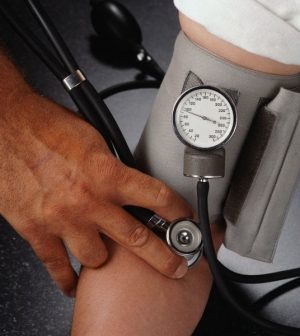- Skip Storing This Everyday Product in the Fridge Door
- Green Tea + B3 Pairing May Boost Brain Health
- Navigating Your Midlife Crisis: Embracing New Possibilities
- City Raccoons Showing Signs of Domestication
- Mapping the Exposome: Science Broadens Focus to Environmental Disease Triggers
- One Week Less on Social Media Linked to Better Mental Health
- Your Brain Changes in Stages as You Age, Study Finds
- Some Suicide Victims Show No Typical Warning Signs, Study Finds
- ByHeart Formula Faces Lawsuits After Babies Sickened With Botulism
- Switch to Vegan Diet Could Cut Your Greenhouse Gas Emissions in Half
Home Monitoring Works for Blood Pressure Patients

Home blood pressure monitoring can improve control of high blood pressure and reduce health care costs.
That’s the conclusion of a preliminary study that included 2,550 adults with uncontrolled high blood pressure. They each received free home blood pressure monitors, online and print resources for tracking their blood pressure readings, and reminders to check their blood pressure.
By the third visit to their doctor, nearly 67 percent of the patients had their blood pressure under control. By the sixth visit, the rate was about 60 percent, the study authors reported.
The decline between the third and sixth visits was due to doctors’ adjusting blood pressure medications based on information from home blood pressure monitoring, according to study author Roy Champion. He’s a clinical quality registered nurse at Scott and White Health Plan in Temple, Texas.
Patients only had to see their doctors a few times to determine the ideal amount of medication, Champion said.
By the time the patients stopped using the home monitors, systolic blood pressure (the top reading) had decreased an average 16.9 mm Hg and diastolic blood pressure (the bottom reading) fell an average 6.5 mm Hg, the researchers said.
They presented the findings Saturday in Chicago at an American Heart Association meeting on high blood pressure. The study was funded by a grant from the heart association.
In the following six months, nearly 80 percent of the study participants achieved blood pressure under control using what’s known as the Healthcare Effectiveness Data and Information Set 2018 standards. And 72 percent achieved blood pressure control under the 2017 American Heart Association/American College of Cardiology guidelines.
Both organizations endorse the use of home blood pressure monitoring for managing high blood pressure, the researchers said.
“Even with the more stringent guidelines, we showed home blood pressure monitoring is vital to achieving control among hypertensive patients,” Champion said in a meeting news release.
Each monitor and accompanying kit cost an average of $38.50 and led to significant cost savings. Each patient had 1.2 doctor office visits a year and much lower emergency department and medication costs, the researchers said.
Home monitoring plus doctor visits to measure blood pressure can help avoid readings thrown off by what doctors call “white-coat hypertension,” when blood pressure is high in a medical setting but not in everyday life. And the tandem treatments can also uncover “masked hypertension,” when blood pressure is normal in a medical setting but high at home.
High blood pressure can cause serious health threats, including heart attack, heart failure, stroke and kidney disease.
Since the study findings were presented at a medical meeting, they should be considered preliminary until published in a peer-reviewed journal.
More information
The U.S. National Heart, Lung, and Blood Institute has more on high blood pressure.
Source: HealthDay
Copyright © 2025 HealthDay. All rights reserved.










